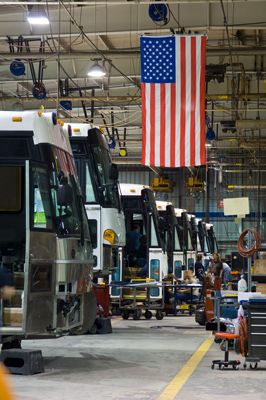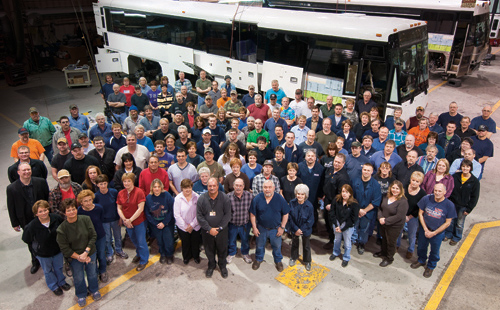 Public and private transportation drives jobs and opportunities
Public and private transportation drives jobs and opportunities
By Michael P. Melaniphy
Public and private coach operators across the country are vying for and receiving federal funding under the recently passed American Recovery and Reinvestment Act (ARRA), more commonly known as stimulus funding.
There is a lot of talk these days about shovel-ready projects. While it would be difficult to actually find a shovel on the production line of the Motor Coach Industries (MCI) factory in Pembina, ND, it is fair to say the nearly 250 workers at that facility are wrench-ready.
ARRA funding is finding its way to places like Pembina, a town of about 600, through federal grants to state DOTs across the country. At this ISO-certified facility MCI incorporates a lean production system and a process of continuous improvement to keep the plant competitive. For its effort in these areas, MCI is able to attract talented workers throughout the region.
Funds appropriated to states such as New York, Tennessee, Iowa, Texas and Utah also are helping to retain jobs in North Dakota. These are high quality, full-time positions that require skill sets to apply evolving technologies to modern motorcoaches. Though most people know American-owned and operated MCI as the maker of intercity tour and charter coaches, the company has actually been a fixture in the U.S. public sector for the last 40 years. MCI opened its Pembina plant in 1963 to better serve the U.S. market. Today, the plant completes all variants of the MCI D-Series coaches including those that require Buy-America compliance.
MCI currently builds the only hybrid-powered over-the-road coaches in North America. Like most of its other transit-appropriate models MCI also fashions its hybrid commuter coach after the best selling D-model.
More than 4,000 D-Series coaches operate daily at public transportation agencies across the county, and also serve private rural access grant recipients, the U.S. Army, Navy and Air Force, as well as the Bureau of Prisons and other U.S. Federal agencies. By the end of this year MCI will deliver federally funded coaches to 43 states.
The multiplier effect
Investing transportation stimulus dollars into communities both large and small enjoys a multiplier effect that stretches far beyond transit agency service. An order for new coaches must include the procurement of the many components necessary for production from sources throughout North America. MCI new-coach production uses more than 4,000 suppliers that include numerous small, DBE and WBE businesses. Considering supplier support for the aftermarket needs of a coach over its lifespan, the number of MCI-related vendors totals over 10,000 individual companies in all 50 states.
The American Public Transportation Association (APTA) estimates that every job created or retained at a bus OEM creates eight to 10 more jobs throughout the supply chain. Federal stimulus spending directly supports and even expands these job opportunities. Many employees on the supply side are starting work months before the coaches go into production to meet component lead-time requirements.
Beyond ARRA funding, MCI is also a major exporter, having delivered nearly $50 million worth of coaches outside of the U.S. in 2008 alone. These vehicles went to both private and public operators and further contributed to the U.S. economy.
Independent operators must act now
While traditional public transit operators already know their ARRA funding allocations, there may still be funds available at the state DOT level for private-sector operators interested in running regular routes to underserved rural communities.
The federal government has committed more than $77 million in grant money for the Intercity Bus Program to serve towns with populations under 50,000, but the deadline is fast approaching. The program formally known as the Federal Transit Administration 5311(f) program provides private operators capital funding for intercity coaches to ensure connectivity to underserved rural areas, especially those not served by rail or airlines. In the past, these funds paid up to 80 percent of the capital cost of new equipment. This year, the ARRA funding is 100 percent. Operators must act now to meet the July 1 deadline for state agencies to submit ARRA grants to the federal government. Equipment must be Buy-America compliant, Altoona-tested and have the capacity to carry luggage. “The new administration recognizes the need and the important role over-the-road coaches play in connecting people to places to improve access to health care, commerce and job opportunities. It is up to us to make it happen,” says Pete Cotter, MCI senior vice president and general manager, new coach business. “The new funds present a phenomenal opportunity for line haul operators to make a difference in underserved communities.” Fifty states have already received their funds and it is now up to the governors and DOT officials to determine how to spend the money. Operators are encouraged to go straight to their state DOT officials and begin a dialogue.

He says to meet the 5311 requirements, operators must be in compliance with Federal Motor Carrier Safety Administration (FMCSA) regulations and be ready to purchase and pay for the coach, as the federal programs work on a reimbursement basis through the state DOT after the purchase.
As to be expected, these federal funds do come with stringent standards. The government requires regular, detailed reporting, and has hired extra inspectors to ensure that FTA-funded equipment is being properly acquired and used only on routes and in the capacity as outlined in the grant. In addition, the ARRA has also allotted funds to promote the implementation of green technologies. Public sector and nonprofit agencies may be able to apply for federal funds from the FTA or EPA for programs to reduce emissions or energy utilization. Eligible projects range from DPF exhaust filters to hybrid buses.
More opportunities for intercity coach operators
An ultimate goal of this administration is an intermodal transportation network to connect all parts of the U.S. It will require the best use of every transit mode from high-speed rail to commuter buses to bring people from feeder routes into the most-populated areas. Suburban commuters represent the largest percentage growth area in terms of new customers. For forward-thinking transit managers, commuter coach routes can even serve to establish more travel corridors for future commuter rail lines.
Bus and coach routes need to change as transportation patterns and business districts change. In natural and man-made disaster situations where large groups require immediate transport, over-the-road coach services also have proven vital in overall emergency response planning. Federal funding including the newly enacted ARRA stimulus funding is making a real, positive difference in communities across this country. Investing in public transportation infrastructure is good policy for our country and the economy, and a great investment for our industry.
Michael Melaniphy serves as vice president, public sector for Motor Coach Industries (MCI), Shaumburg, IL, and is currently second vice-chair of the American Public Transportation Association (APTA), a business member of its board of governors, and chairs the APTA procurement committee.
